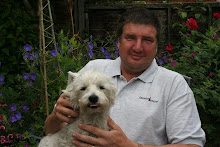 |
Mary and Isabelle enjoy their last few days, here chatting to
one of the westies |
This is another one of those posts you might like to avoid if you do not want to know about the messier side of meat production. The back end of this week saw our two Berkshire gilts 'finished' at just over 6 months and weighing around 60 kg each live-weight. I have posted before that these ladies were way lighter than last year's Tamworths who were fed to demand and laid down what we thought was an excessive amount of fat. Even JD Bob was a little disparaging about their size, but we know he comes from a tradition of pig rearing in Ireland 40+ years ago when very fat baconers were the thing. No, we stuck to our guns and we are delighted with them.
 |
Practise loading - the pigs get fed in the trailer for 2 days prior
to D-Day. That way they load without fuss when you need them to |
They were booked into pork butcher Webb's in Castlerea for Thursday morning which puts us into needing to practise-load for the Monday afternoon and for Tuesday and Wednesday. Readers here last year will know that we built a special 'race' from their gate to the top of that slope into which we could 'plug' the trailer with no room for pigs to sneak round the sides. On D-3 we then give them a nice long, leisured explore. It doesn't do to hurry pigs anywhere. You are better off throwing down some fruit and letting them find it at their own speed.
 |
Who needs a fridge-van? 4 half pigs and a bag
of 'bits' fit into the Fiat with the seat down. |
Then on D-2 and D-1 we feed them in the trailer and they soon get into the rhythm of sprinting up the race and the trailer ramp, shoulder-barging their sister to one side in order to claim the 'best' bowl of meal. Then on D-Day morning you put the bowls in with only fruit (no nuts) and up they go so that you can quietly close the trailer door behind them. The 'no nuts' thing is just because the butchers prefer you to 'fast' pigs prior to slaughter so that the innards are more manage-able at the cleaning stage (Sorry if you're just enjoying your tea!)
 |
| I get to play with the new bone-saw |
This year we had decided to have a go at the butchery ourselves. The slaughter (including cleaning the carcass, scalding and scraping and splitting in half down the spine, costs €50 per animal and the butchery costs another €50, so we were saving €100. We had a rough idea what to do and, for a laugh, we watched a You-Tube video on "Cutting up half a 'hog' ", 2 and a half minutes of American 'good aul' boys' complete with bushy beards and baseball caps plus random discussions of last night's drinking session and chicken noises off! However, this unlikely 'training resource' explained perfectly where to make the first cuts, how to pull out the 'leaf-lard' (big sheet of top-quality fat which lines the abdominal cavity) and other useful tips, so don't deride it till you've tried it.

In we went, then with all the big chopping boards mustered on the (bleached and scrubbed!) dining table and the knives and my new bone-saw all razor sharp. We completed the first animal in about an hour with a nice ham selected and readied for brining for Christmas and a whole leg chosen for a dry-cure 'Parma' ham style air-dried long mature. I took a break to walk dogs and for coffee, before we tackled the 2nd animal. We found that we were getting better with each half-carcass - some of the first cuts were a bit 'rookie apprentice' but the 4th was a better, more pro-job. I was particularly pleased with how the proper saw worked having only before experienced a carpenter hack-saw (worse than useless). If anyone reading this is contemplating butchery, then your bone-saw will be €40 or so very well spent. It cuts through bone in a jiffy and never clogs with sinew, bone fragments or myelin sheath. We also like quite thick pork chops and we were delighted to find that by sawing through the 'discs' of the spine and running a knife up between the ribs we got fewer, but thicker chops. If you look at supermarket chops you will find that they are half a vertebra and various sharp-ended part ribs because they are band-sawed through perpendicular to the spine, every half inch or so regardless of where the ribs and vertebrae sit.
 |
| The Christmas Day ham. |
We weighed one of the halves and found it to be 21.3 kg, so a whole animal is 42.6 kg, which is a very useful 71.6% conversion live/carcass. That is about right for pigs. We had also had the heads, hearts and livers back from Mr Webb and the kidneys were still in the carcass halves. Mr Webb had also very generously offered to split the heads ready for the brawn (head-cheese) making and I only needed to cut them again top from bottom (separating the jaws) for them to fit into Liz's big brawn-pots. As I write this, they are now boiled or boiling gently prior to all the onward processing tomorrow. We love our brawn and Liz has found a smashing recipe which uses plenty of parsley; a herb we have in abundance growing in the polytunnel.
 |
A leg gets well smothered in dry-cure
mix (salt, sugar, star anise,
bay, peppercorns, coriander and chilli) |
We also decided to try some more salt curing. We picked out a nice cut of ham weighing 6 kg and have brined it in a wet-cure mix of salt, sugar, bay, onion, garlic, lovage, mustard seeds, cloves, chilli, allspice and peppercorns. This will get just 48 hours in brine, then be cleaned, patted dry and frozen till December. Next we chose a full leg intending to do the 'Parma' ham salt cure / air dry on it. This gets a longer cure (21 days) smothered in a dry mix of salt and sugar plus I had some fun with the big pestle and mortar "lightly crushing" a mix of star anise, bay, peppercorns, coriander and chilli. I love all that pounding. I think my favourite expression in this area is when you "pound the garlic to snot". 'Nuff said, maybe. The cure recipes have come from our lovely new books from Steak Lady. Thanks, SL!
 |
Liz surveys the wreckage.
How am I going to fit all this into the freezer? |
Well, 4 hours or so in we were all done. Mountains of bagged pork cuts and bags of scraps, dog bones and suet have been assigned to their places in the big stand-up freezer(s). The sawn-up heads are being reduced to brawn. The cured joints are sitting in their cure. There was only ever going to be one thing on the menu for supper tonight - those lovely thick pork chops.
Liz served them with slices of Ottolenghi's cauliflower cake and we both decided two small edits of the recipes to suit local conditions. OUR pork chops need nothing like the amount of butter that Nigel Slater uses for dry old supermarket chops and OUR eggs do not need the support of all that yellow turmeric to make the 'cake' look bright. The dogs have also done very well today what with some bits of raw pork rib (their absolute favourite food) during the butchery and some roasted ear and tail later on as a treat.
 |
| More dustbin lid art. This time for the turkey 'finisher' |
That was that. Pigs and butchery all done for 2015. Next year we are fairly sure we will do this again but try with the Tamworth ginger pig breed again but on our 'maintenance diet' of 1.4 kg meal per animal per day; to see if we can reduce the thickness of that subcutaneous fat layer. Meanwhile the pig patch is in recovery mode, even though it is very poached up and wet. We plan to let it all dry out a bit then slot some spring bulbs into each hoof print, rake it over and sow buckwheat and more phacelia into the bare areas. We feel nicely 'Harvest Festival' ish. All is safely gathered in, freezers are rammed with meat, Autumn is looking like it is here and we are both very well fed tonight and pleasantly mellow on Lidl's very quaffable 'Baturrica 2010' (tarragona) Spanish plonk. Cheers.












3 comments:
Hardly plonk Matt, one of the best wine growing regions in Spain, in fact in 2004 it was voted the best wine by the vintners in London and was selling for £400 a bottle. Best served slightly chilled.
Great going, Matt, very interesting post!
You'd be the expert on Spanish wines, Anne. I wouldn't like to give anyone the impression we were paying £400 per bottle. This was Lidl's "plonk-ish" version, then, for about €7 a bottle, but very nice. We will definitely be buying more of it. The pork chops, incidentally, were fried fairly gently in a mix of the oil with crushed juniper berries and lemon juice. They had an interesting 'gin' type smell and tasted delicious.
Post a Comment